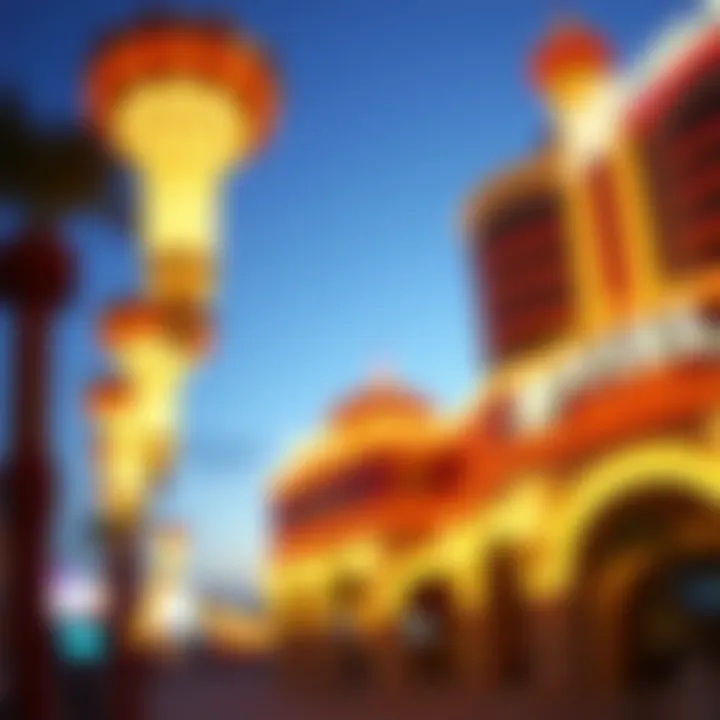Riviera Las Vegas: Legacy and Transformation Explored


Intro
The Riviera Las Vegas stands as a monument to not just the glitter of casinos but also to the profound changes that shaped a city and its culture. Opened in the early days of the Las Vegas Strip, the Riviera was far more than a mere gaming facility; it was an emblem of luxury and style that altered the skyline and the gaming experience of countless visitors. For over half a century, this casino played host to stars, high rollers, and ordinary patrons seeking a taste of excitement and an escape from their daily lives. As we delve into the intricacies of its foundation, architectural splendor, and eventual downfall, we uncover not just the history of a building, but the spirit of an era.
With its inception in the 1950s, the Riviera was one of the first properties to warrant a modern gambling atmosphere combined with extravagant entertainment. From the marquee lighting that reflected the bold aspirations of the city’s growth to the elegant interiors that provided a backdrop for memorable performances, the Riviera left an indelible mark on Las Vegas's identity. But beyond its brick and mortar, the Riviera shaped a collective memory for generations— a shared narrative interwoven with triumphs, losses, and legends.
As we journey through this layered exploration, it becomes essential to grasp both the physical and cultural shifts that occurred during the casino's life. Each chapter will not only illuminate significant events held within its walls but also reflect on the evolving landscape of gambling itself. The legacy of the Riviera continues to inspire modern establishments, prompting reflections on both its celebrated history and the lessons learned in its wake. This is not merely about a casino that welcomed thousands; it is about understanding what the Riviera symbolizes in the ever-competitive realm of gambling and entertainment.
Foreword to Riviera Las Vegas
Riviera Las Vegas stands as a towering chapter in the annals of the Strip’s illustrious narrative, its history woven with the threads of glamour, risk, and pure entertainment. As we embark on this journey to explore Riviera's legacy and transformation, it becomes apparent that understanding its origin and significance is crucial. It is not merely a tale of a casino’s rise and fall but rather an intricate look at how one establishment helped shape the very landscape of gambling and entertainment in Las Vegas.
Overview of the Casino
Opened in 1955, the Riviera was a shining beacon of luxury and allure in the early days of Las Vegas. With a striking architectural style that borrowed from the Mediterranean inspiration, the casino was not only a place for gambling, but it also became a haven for high-profile entertainers and a vibrant hub for visitors wishing to escape the mundane. The casino offered a luxurious experience, featuring a vast gaming area that included table games, slot machines, and an atmosphere that was both inviting and exhilarating. Over the years, it hosted renowned performers such as Frank Sinatra and Liberace, further embedding itself into the fabric of Las Vegas’ cultural scene.
The casino’s distinct neon lights and vibrant atmosphere made it a staple of the Strip, drawing in visitors from near and far. Its luxurious rooms and extravagant decor elevated the guest experience, ensuring that many who passed through its doors left with cherished memories. This overview paints a vivid picture of how the Riviera represented a blend of history and modernity, encapsulating the essence of Las Vegas itself.
Significance in Las Vegas History
The Riviera holds a special place in the history of Las Vegas, functioning not just as an entertainment venue, but as a symbol of the evolution of the Strip. Its opening coincided with a period of growth and innovation in the gambling industry, showcasing the shift from small, modest establishments to sprawling resorts that offered more than just slots and tables.
The Riviera was among the first resorts to introduce luxury in the form of lavish accommodations and high-end dining, setting new standards that would ripple throughout the industry.
This significance extends beyond its architectural design to its role in the gaming culture of Las Vegas. It was at the Riviera that many aspects of modern casino gaming emerged, with themed areas and entertainment formats that guided the creation of future resorts. Additionally, it served as a gathering place for early gambling pioneers, fostering a sense of community that further solidified Las Vegas’ reputation as the gambling capital of the world.
In summation, Riviera Las Vegas wasn't just a casino; it was a profound influencer that shaped the dynamics of regional gambling, entertainment, and culture. Its legacy continues to resonate within the hearts of those who experienced its grandeur and remains a focal point of interest for both historians and modern patrons who marvel at the evolution of Las Vegas.
Origins of Riviera Las Vegas
The origins of Riviera Las Vegas are not merely about bricks and mortar; they reflect a vision that was crafted during a transformative era in the gaming industry. Established in 1955, the Riviera represented a significant milestone in the evolution of not only Las Vegas but the entire casino landscape. Its beginnings set the stage for the lavish experiences that have shaped expectations in modern casinos today. Understanding its inception allows us to appreciate the ambitious spirit that marked the early days of the Strip, where glamour and excitement were woven into the very fabric of the city.
Founding and Inception
The Riviera Las Vegas was the brainchild of the renowned hotelier and prominent figure in the gaming industry, Milton Prell. Situated on the northern end of the Las Vegas Strip, it was a game changer in the casino scene. The Riviera sought to create a high-end atmosphere, targeting affluent visitors who craved sophistication along with their nightlife. The casino opened its doors with a grand flourish, immediately capturing attention with its unique offerings and upscale environment.
The combination of glitzy neon signs and elegant decor made the Riviera stand out. Not only did it have one of the largest gaming floors in Vegas at the time, but it also introduced many innovative features. Think about this: when the casino first opened, it boasted air conditioning, which was a relatively rare luxury for Las Vegas establishments back then. Coupled with a splashy ballroom and extravagant entertainment options, Riviera quickly established itself as a go-to destination for high rollers.
A photo of the iconic Riviera's exterior.
Architectural Style and Design
The architectural style of the Riviera was a blend of Mid-Century Modern and classic Italian influences, characterized by bold lines and vibrant colors. Designed by architect Paul Williams, the space emphasized elegance while incorporating elements that felt relaxed and inviting. Notable features included sweeping views of the Strip from many of the rooms and a unique façade adorned with stunning details that drew visitors’ eyes from afar.
Key highlights of its architectural design include:


- Incorporation of Natural Light: The design featured expansive windows that allowed ample sunlight in, fostering a warm atmosphere inside the casino.
- Vintage Aesthetic: The interior design utilized materials like brass, glass, and rich fabrics that embodied the luxury of the era.
- Cascading Pools: Unique swimming pool designs enhanced the leisure appeal, where guests could escape the desert heat under picturesque palm trees.
"The Riviera was more than just a casino; it was a hub of entertainment, a pioneer in luxury, and a testament to what Las Vegas could symbolize."
— Casino Historian, Mark Thompson
Cultural Impact of Riviera
The Riviera Las Vegas stands as a testament to the rich cultural tapestry of entertainment that the city offers. More than just a casino, it served as a landmark that blended glamour, history, and innovation. Its unique position in Las Vegas's timeline highlights not only the evolution of gaming but also the transformations in entertainment and popular culture.
Entertainment Offerings
Featuring Iconic Performers
Throughout its existence, the Riviera was home to a plethora of iconic performers. Legends like Liberace and Danny Gans graced its stages, drawing in audiences from around the world. These performers didn't just provide entertainment; they etched their names into the annals of Las Vegas history. The key characteristic of featuring such talent was its ability to create an allure that transcended the gaming experience, establishing the Riviera as a destination for world-class entertainment.
The significance of this aspect lies in its contribution to Las Vegas's identity. Many patrons came not only for the chance to gamble but to witness these extraordinary acts. This blend between gaming and entertainment became a hallmark of the Riviera.
There was also a unique feature about these performances; they weren’t just shows; they were experiences. The lavish costumes and grand sets transformed a night out into something memorable, a lavish affair perfect for visitors seeking the quintessential Las Vegas feel. However, the challenge was balancing this high-caliber entertainment with the essence of a casino, ensuring that the thrill of gaming remained a central draw, while also catering to the audience seeking top-notch performances that left in deep admiration.
Signature Shows and Events
In addition to iconic performers, the Riviera’s signature shows and events were a cornerstone of its cultural significance. From magic shows to comedy acts that could set the room on fire, the Riviera didn’t shy away from diverse entertainment. Each event was carefully crafted to engage visitors, enhancing the casino’s reputation as a hub for unforgettable experiences.
The hallmark of these signature events was their remarkable diversity. This was not just a venue for traditional gambling; it was a melting pot of cultural expressions that attracted different demographics. This not only broadened the appeal but also helped solidify the Riviera’s status in a competitive Las Vegas market.
Moreover, each show often celebrated history or offered a glimpse into various cultures, broadening the patrons' horizons, thus reflecting a broader societal context. However, the constant evolution of the entertainment landscape in Las Vegas posed challenges. Keeping events fresh and engaging required continual innovation, as new hotels and casinos aimed to capture the attention of audiences with unique offerings.
Influence on Casino Culture
The Riviera’s influence on casino culture is profound. Its combination of thrilling gaming with top-tier entertainment pushed other establishments to elevate their offerings. The way the Riviera integrated shows within its gaming atmosphere encouraged a transformation in customer expectations. Patrons began to see casinos not just as places to gamble, but as full-fledged entertainment venues.
"The Riviera was not merely about gambling; it was a cultural experience that changed the Las Vegas landscape forever."
From this perspective, one can understand how integral the Riviera was to the ongoing narrative of Las Vegas, underscoring its legacy even long after its closure.
Riviera and the Las Vegas Strip
The narrative of the Riviera Las Vegas is intertwined with the emergence and evolution of the Las Vegas Strip itself. This location, known worldwide for its electrifying atmosphere and extravagant resorts, evolved rapidly over the decades, and the Riviera played a crucial role in shaping that landscape. The casino was not just a place for gaming; it served as a barometer for shifts in trends, culture, and the very essence of leisure.
Competitive Landscape
During its heyday, the Riviera found itself in a highly competitive environment alongside other iconic properties. The emergence of mega-resorts in the 1990s put pressure on Riv's traditional business model. The establishment of properties like the Bellagio and Caesars Palace, which offered not only gaming but also expansive amenities—such as fine dining, high-end shopping, and elaborate entertainment—marked a turning point. In this climate, the Riviera faced the challenge of appealing to a changing demographic of visitors who sought opulence alongside their gaming experience.
While the Riviera had its distinct charm, characterized by its French Riviera theme and a vibrant nightlife, the sheer scale and diversité of competitors often overshadowed it. Unlike newer neighbors who could afford to invest in lavish renovations, the Riviera struggled to keep up due to its older infrastructure.
Yet, this competition spurred a sense of nostalgia among many visitors. Those who frequented the Riviera recognized it as a bastion of classic Vegas charm. The casino's storied past became an asset, branding itself as the place where the legends of entertainment and high-stakes gambling once roamed the halls.
Despite these challenges, the Riviera remained a critical player on the Strip, contributing to its rich tapestry even as it faced an uphill battle against glitz and glamour.


Memorable Guests and Events
The Riviera Las Vegas has hosted a plethora of notable guests and events throughout its history, each leaving indelible marks that contribute to its legacy. Names like Elvis Presley and Frank Sinatra weren't just performers at the Riviera; they were cultural icons who lent an air of prestige to the venue. Their shows, often sold out, brought in fans not just for the music but for the experience of being part of something larger than life.
Furthermore, the casino was known for its high-stakes poker games, where the likes of Doyle Brunson and Johnny Chan would often be seen at the tables. These events lured in not only hopeful gamblers but also media attention, creating a buzz that resonated beyond the borders of Las Vegas.
"You haven’t truly experienced Vegas until you’ve heard the clinking of chips in the Riviera poker room."
Special events, like themed galas and charity fundraisers, also occupied various chapters in the Riviera's story. They provided a unique intersection between glamour and purpose, reinforcing its status as a social hub. Each event added layers to the property’s identity, providing locals and tourists alike with lasting memories.
Ultimately, the stories of memorable guests and events at Riviera are not just anecdotes; they represent a rich history at the heart of the Las Vegas experience, ensuring that the casino's influence will echo through time.
Decline and Closing
The decline and subsequent closing of the Riviera Las Vegas mark a pivotal chapter in the narrative of not just the casino itself but the broader evolution of Las Vegas as a whole. This section delves into the multiple factors that contributed to this downturn, shedding light on how shifts in the gambling landscape can influence the fate of a major establishment. Understanding this decline offers insight into the dynamic nature of the Vegas Strip and its ever-changing environment.
Changing Market Dynamics
Throughout its operational years, the Riviera faced significant market dynamics that transformed the competitive landscape of Las Vegas. As the decade rolled on, a wave of glitzy, modern hotels and casinos emerged, drawing in visitors with their novel attractions and experiences. The rise of mega-resorts like Bellagio and Wynn changed the game.
Visitors began seeking more than just gaming; they desired all-encompassing entertainment experiences. The Riviera, however, struggled to keep pace, relying on the same offerings that had once captivated guests. This created a perception, albeit sometimes unwarranted, that it was lagging behind its competitors.
The evolution of preferences among gamblers and the general public cannot be overstated. Traditional gaming habits began to shift towards online platforms as well, further eroding the Riviera's customer base. Key barriers in modernization also hindered its agility in catering to the new demands of contemporary gamblers.
Final Days of Operation
As the 2010s approached, the signs of distress became abundantly clear. The decision to close the Riviera in 2015 was not made lightly. After struggling with declining foot traffic for years, it was clear that the operations weren't sustainable. The last guests felt a tinge of nostalgia as they stepped through the iconic entrance for the final time. Though some ventures tried to breathe new life into the establishment, its charm couldn’t mask the harsh realities of its fading relevance.
In the closing months, the casino nostalgia intertwined with palpable sadness, as many long-time patrons reflected on their treasured memories. From early vacations to celebratory milestones, these experiences are forever etched in the minds of loyal visitors. The last days were filled with a mix of celebration and mourning, as the property prepared for its inevitable transition into the realm of memory.
"It was like saying goodbye to an old friend, one that had shared laughter and dreams, but who simply couldn't keep up with the times."
Ultimately, the last roll of the dice at the Riviera occurred not just as an end, but a somber signal of how tradition must adapt to survive in an evolving landscape. The closure echoed across the Las Vegas Strip, serving as a reminder of the fickle nature of fortune and the ever-present shadow of change.
Understanding the decline and final days of the Riviera helps underline the resilience required in an industry that incessantly swings between highs and lows, influencing the vibrant character of gaming establishments into the future.
Demolition and Aftermath
The demolition of the Riviera Las Vegas marks a significant chapter in the ongoing transformation of the Las Vegas Strip. Once a glittering icon of gambling and entertainment, the casino faced challenges that ultimately led to its closure. Understanding the process of demolition and the subsequent reactions from the public and media provides deep insight into the changing dynamics of Las Vegas and the impact of losing such a storied establishment.
Process of Demolition
Demolishing a site as storied as the Riviera was no small feat. The process began with meticulous planning to ensure safety and efficiency. First, structural engineers examined the building to determine the best methods for demolition. The chosen approach involved both traditional methods and advanced techniques. Heavy machinery like excavators played a role, but the most striking aspect was the controlled implosion. This technique allowed for a swift takedown of the iconic towers, reducing the risk of collateral damage to surrounding properties.
Amid the noise and chaos of machinery, safety measures were strictly enforced. Nearby hotels and casinos were fortified to prevent any debris from causing harm. Only a small window of time was secured for this event, to minimize disruption in the ever-bustling Las Vegas Strip. One could say it was like dancing on a tightrope, balancing the old with the new. On the day of the demolition, crowds gathered to witness history unfold, a spectacle that was both somber and exhilarating.
Public and Media Reactions


The reaction to the Riviera's demolition was a tapestry of emotions, ranging from nostalgia to a mix of excitement for the future. Social media buzzed with sentiments that reflected the feelings of those who had spent countless hours enjoying the casino's offerings.
"The Riviera was part of my youth, a place where memories were made with friends and family," shared one former patron in a public forum.
This sentiment was echoed across various platforms, as both locals and tourists paid their respects. Media outlets also took notice, showcasing the emotional weight of the demolition. News articles featured opinions from historians who highlighted the Riviera’s role in shaping Las Vegas's gambling culture during its prime. While some praised the progress and modernization of the Strip, others lamented the loss of a historical icon, a relic of a bygone era.
In the days leading up to and following the demolition, public opinion shifted back and forth. Some expressed anger at the loss of its historical significance, feeling that such landmarks should be preserved. Others saw the demolition as a necessary step towards reinvention, symbolizing the ever-changing face of Las Vegas as it evolves to meet modern demands.
The aftermath of the demolition left a blank canvas on the Strip, sparking conversations about what lies ahead for the site of the Riviera. Would it be the foundation of a new resort or perhaps a recreation space celebrating the memory of what once was? As dust settled on the vacant lot, it became clear that the legacy of the Riviera was not just tied to its physical structure but to the memories, stories, and experiences it had gifted to so many.
In the grander picture, understanding the demolition and its aftermath allows modern casino enthusiasts and developers to reflect on what they value in their gaming spaces, whether it's history, nostalgia, or the thrill of the present. The legacy of the Riviera will linger, no matter what sprouts up in its place.
Legacy of Riviera Las Vegas
The legacy of Riviera Las Vegas is a multifaceted topic, steeped in rich history and cultural significance. While the casino may have closed its doors, its echoes can still be heard throughout the Strip and beyond. Riviera not only paved the way for future developments but also left an indelible mark on the hearts of those who experienced its unique allure. Assessing its legacy involves diving deep into the various elements that forged its identity, from architectural finesse to unforgettable entertainment offerings.
Impact on Future Developments
The influence of Riviera Las Vegas is evident in many contemporary casino designs and operations. It bridged the gap between classic Vegas charm and modern amenities, illustrating how nostalgia can coexist with innovation. Rivetingly, its establishment heralded a shift in the casino experience, steering away from merely being gambling halls to full-fledged entertainment destinations. Future developers took notes, creating expansive spaces that include casinos, hotels, and diverse attractions.
- Architectural Inspiration: Riviera's mid-century modern design provided a template that many resorts married into their blueprints.
- Entertainment Model: The portfolio of performances that graced its stages set precedents for showrooms across town, emphasizing a blend of talent and opulence.
- Consumer Experience: With its various schemes, Rivera emphasized guest experiences. Designers aimed to recreate that feel; everything from branding to layout often incorporates lessons learned from Riviera's heyday.
It is also worth noting that Riviera's strategic changes in response to market dynamics subtly shaped the operational strategies of future casinos. The intermingling of technology and customer service in recent establishments can be traced back to the lessons learned from the Riviera's late challenges. In essence, with every brick that was laid at the Riviera, a narrative was penned that inspired those who followed their lead.
Reflections from Patrons and Historians
The sentiments of patrons and historians alike paint a rich tapestry of appreciation and nostalgia. Visitors cherish the memories made within the glittering halls, often reminiscing about magical nights filled with laughter, music, and the thrill of gaming. For many, the Riviera represented not only a place of leisure but a sanctuary from the mundane. Here are some notable reflections:
"Riviera was the place where people felt they could escape reality, where dreams intertwined with fate at the card table." — Casino Historian
- Patrons' Stories: Many guests share how their first gambling experiences, weddings, or even friendships began at Riviera. It's not only the games they recall but also the vibe and connections made while sipping cocktails under the neon lights.
- Historical Perspectives: Experts acknowledge the casino as a crucial player in shaping the Vegas casino landscape. The Riviera played a significant role in giving voice to those who sought entertainment beyond gambling, thus influencing public expectations.
Ultimately, the legacy of Riviera Las Vegas transcends its physical presence. It lives on through the stories of its patrons, the transformations that followed, and the echoes of laughter and music that still float across the Strip. This exploration, whilst touching on the past, also ignites curiosity about what the future might hold for Las Vegas's ever-evolving narrative.
End
As we wrap up our exploration of Riviera Las Vegas, it is crucial to reflect on the multi-faceted legacy this iconic establishment left behind. Riviera was not just another casino; it was a beacon of entertainment that shaped the very essence of the Las Vegas Strip. Its stories, once echoing through the vibrant corridors filled with life, now paint a vivid tapestry of highs and lows in gaming history.
Summation of Riviera's Influence
Riviera brought a unique flavor to Las Vegas, attracting gamblers and performers alike. Its architectural elegance and cultural significance are noteworthy elements worth highlighting. The casino was often seen as a launching pad for some of the most prominent entertainers of the era. Frank Sinatra, Liberace, and Martin and Lewis graced its stages, creating a cultural phenomenon that was unrivaled at the time. Beyond entertainment, Riviera played a significant role in the evolution of casino culture, influencing how future establishments would operate and design themselves. Some consider it a catalyst for modernizing the game, with its lavish designs and immersive experiences paving the way for the mammoth resorts of today.
Final Thoughts on Gaming Heritage
The story of the Riviera is one of resilience and transformation. Even in its decline, the narratives shared by patrons reveal the strong emotional ties that existed between the casino and its visitors. For many, the Riviera was more than just a place to gamble; it was a memory-laden space filled with laughter, excitement, and camaraderie.
In thinking about its influence, we must consider how the Riviera, though shuttered, continues to inspire new generations in Las Vegas. The legacy of Riviera Las Vegas is deeply embedded in the fabric of what gaming in the city represents today. It propels us to look ahead, even as we cherish the colorful history of establishments that shaped the landscape of this iconic desert oasis.
"The Riviera wasn't just a casino; it was a rite of passage, a classic marker of Las Vegas history. Its absence is felt, yet its spirit lives on, echoing in every corner of the Strip."
As we reflect on its remarkable trajectory, we can appreciate how the legacy of the Riviera serves as a reminder that buildings may come and go, but the memories created within them are eternal.
For further exploration, dive into pages like Wikipedia's Riviera entry or check discussions on platforms such as Reddit to engage with fellow enthusiasts, curious about the lingering magic of casinos past.















